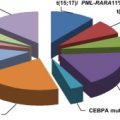Autologous and allogeneic hematopoietic cell transplantation (HCT) is regularly used as a curative treatment option for patients with various disorders, including acute leukemia in adults. The past decade has witnessed dramatic improvements in the reduction of treatment-related mortality (TRM), in part attributable to improved supportive care but also due to better graft selection and donor-to-recipient matching regimens, and the emergence of reduced-intensity conditioning in place of myeloablative conditioning. Despite these advances, HCT remains plagued by the risk of relapse or failure due to graft-versus-host disease, infectious complications, and TRM. This article reviews new approaches that may improve overall patient outcome.
More than 50 years have passed from the initial report from Dr E. Donnall Thomas and colleagues describing the safety (no marrow emboli) and efficacy (some donor engraftment) of bone marrow transplanted into 6 patients with a variety of malignant and nonmalignant disorders. Worldwide, autologous and allogeneic hematopoietic cell transplantation (HCT) is regularly used as a curative treatment option for patients with various disorders, including acute leukemia. Both the chemoradiation or chemotherapy used in the preparative regimen and effects of the graft mediated via the immunologic graft-versus-leukemia (GVL) effect contribute to the success of this approach. At present, acute myeloid leukemia (AML) is the most common indication for HCT; although HCT remains the preferred therapy for a distinct subset of AML patients, acute lymphoblastic leukemia (ALL) patients are also often considered for this therapy. The past decade has witnessed dramatic improvements in the reduction of treatment-related mortality (TRM), in part attributable to improved supportive care but also due to better graft selection and donor-to-recipient matching regimens. The emergence of reduced-intensity conditioning (RIC) in place of myeloablative conditioning (MAC) broadens the applicability of this modality to patients who formerly would be excluded from HCT because of advanced age or comorbid conditions. The demonstration that the graft-versus-leukemia effect eradicates disseminated cancer has fueled efforts to develop immunotherapeutic approaches to tumors. Despite these advances, HCT remains plagued by the risk of relapse or failure due to graft-versus-host disease (GVHD), infectious complications, and TRM. New approaches are emerging that may improve overall patient outcome; many of these novel strategies are reviewed herein.
Graft sources
The earliest HCT transplants used grafts obtained from histocompatible siblings and subsequently from the patients themselves if they were in complete remission (autologous). The past decade has seen the emergence of a significant shift to the use of alternative donors, as shown in Table 1 .






